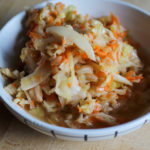Sauerkraut with Carrots
Basic sauerkraut with carrots and caraway for a little twist on the classic.
Ingredients
- 2 heads cabbage I use 1 red and 1 green, feel free to use 2 of the same, if needed
- 3 carrots shredded
- 2 tsp caraway seeds optional
- 1-2 tsp salt sea salt, himalayan salt, or canning salt
- Tools: quart or half gallon mason jars a weight (glass weights or a zip top bag filled with water), fermenting lids or a clean towel and rubber band
Instructions
- Rinse cabbage heads and remove 1-2 of the outer leaves. Reserve these leaves to use as you primary follower (to keep the kraut under the brine--this is SUPER important).
- Remove core and slice cabbage thinly. This isn't an exact science. I slice off the "cheeks" of the cabbage around the core, cut off the top portion of the cabbage above the core (before it becomes a solid mass near the core), then cut into thin strips. Feed the core to your compost bin. Place all cabbage in a large, non-metal bowl, along with the shredded carrots (I peel the carrots then shred on a box grater). Add salt 1 Tbsp at a time, stir, then taste. It should be salty, but not overwhelmingly so. I typically use 1 Tbsp per head of cabbage, so you should need about 2 Tbsp for this recipe, depending on the size of the cabbage heads. Add caraway seeds (if using). Give all of the ingredients a good massage (stir and squeeze) with cleans hands for several minutes. Cover the bowl with a clean towel and let sit for 30-45 minutes. This allows the salt to break down the vegetables a little so they release water to create brine--this is VERY important.
- Once the mixture has been allowed to sit, give it another quick massage with clean hands and see how much brine has developed in the bottom of the bowl. There should be a decent amount (several tablespoons). If there isn't much brine, give the mixture another good massage and let it sit, covered, for another 30 minutes. If taste allows, add a little more salt. Again it should be salty, but don't go crazy.
- Once there is a good amount of brine, its time to pack the jars. With clean hands, begin placing handfuls of the mixture into a quart or half gallon mason jar. If using quart jars, 2-3 may be needed. If using half gallon jars, 1-2 jars should be needed, depending on the size of the heads of cabbage. I usually add 3-4 handfuls to the jar, then pack it down tightly with my fist. This also releases more brine. I continue this process until the jar is just over 3/4 full. Several inches of space is needed to place the weight and to allow for any bubbles that occur during fermentation.
- Once the jars are packed, take the reserved outer cabbage leaves and place on top of the cabbage mixture in the jars. This is called the primary follower. Press the leaf down to allow the brine to come over top of it and see if any of the vegetable mixture floats to the top. If it does, tuck it back under the leaf. All of the mixture needs to stay below the level of the brine. This is VERY important (I'm just going to keep saying that)! Next, a weight is needed, also called a secondary follower. I use glass weights, but a zip top bag filled with water works just fine.
- Once the cabbage mixture is weighted and submerged in brine, cover with a fermenting lid and ring or place several layers of cheesecloth or a clean kitchen towel over the jar, secured with a rubber band. Place the jar(s) in a cool, dark location (I put mine in a corner of my basement that has no windows) and allow to ferment for 7-14 days--set a reminder, especially if the location is out of sight. It is also a good idea to check on the jars each day or so to make sure the mixture is below the level of the brine. If it is not, pack it down.
- Take a taste test at 7 days by sticking a clean fork just under the primary follower to get a small amount of the cabbage mixture. It should smell and taste pleasingly sour and not taste overly salty. If you desire more sourness, let it ferment a few more days until the taste is to your liking.
- Once the kraut has finished fermenting, remove the weight, discard the primary follower leaf and pack the kraut and brine into clean jars. Cap tightly and refrigerate. This kraut should keep in the refrigerator for 6 months to 1 year.
Notes
In the book Fermented Vegetables by Kirsten and Christopher Shockey, they have a mantra, "Submerge in brine and all will be fine." As long as your vegetables are weighted properly and stay below the level of the brine (in a covered jar), there is a good chance all is well with your ferment and it will be delicious. If you haven't clicked any of the links to purchase this book yet and you're interested in getting into fermenting, you should do it right now! I can't say it enough, this book is so helpful!
I've also added a shredded beet or two to this recipe before and it tastes great!
